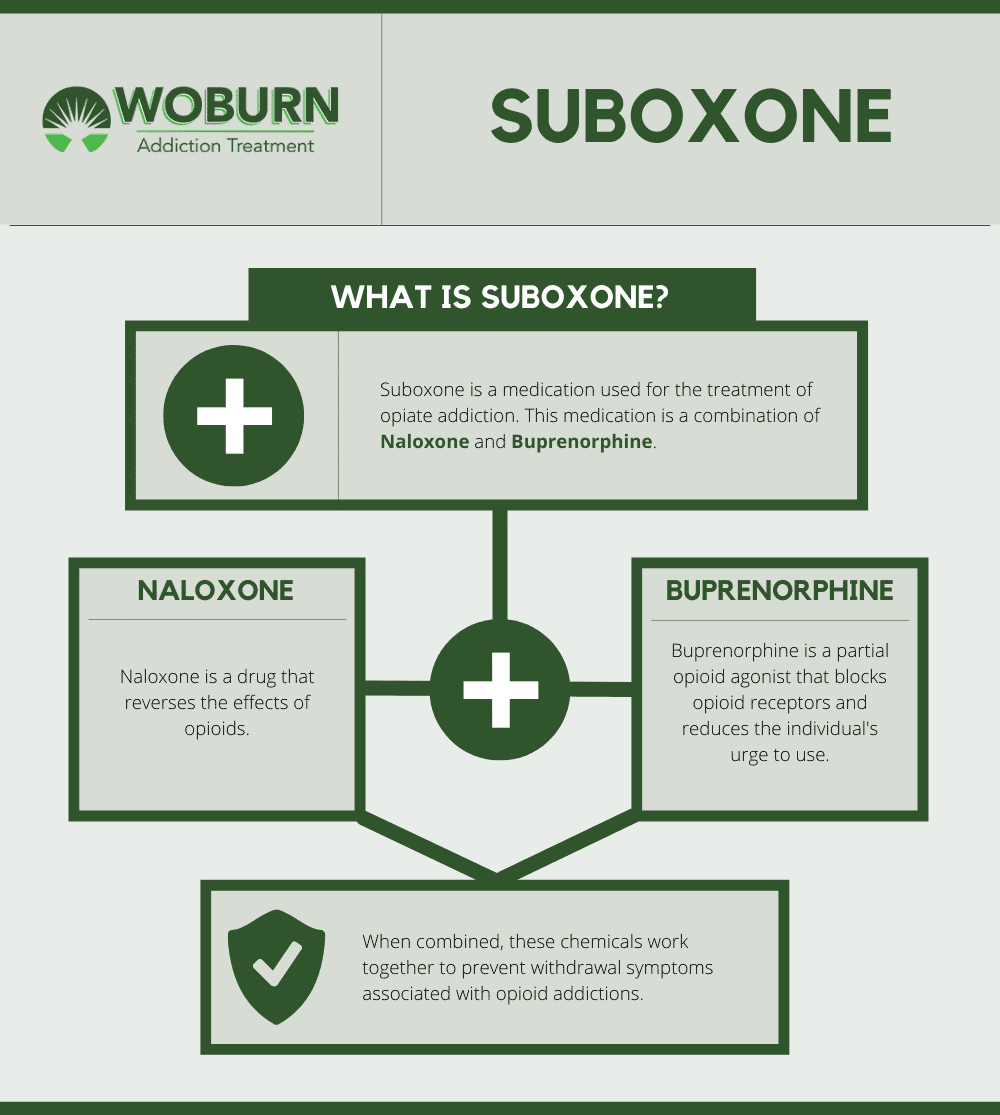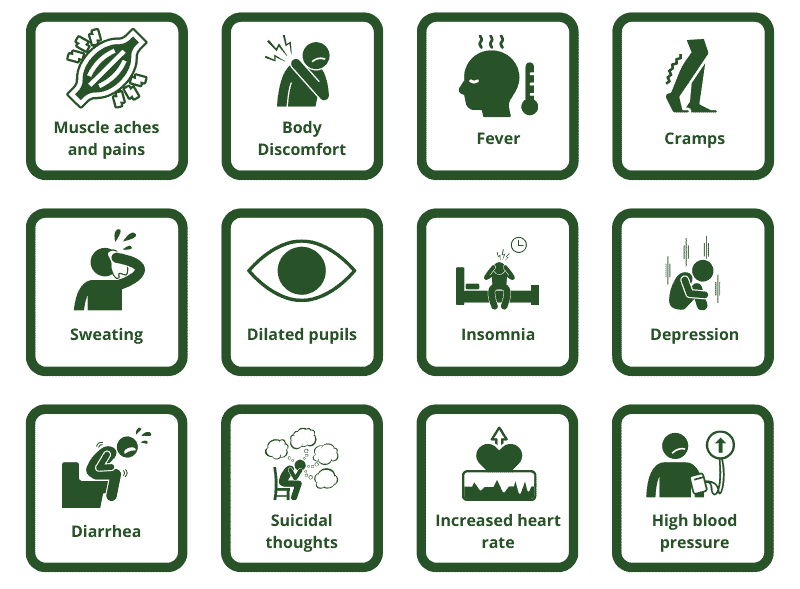Suboxone is a brand-name prescription drug containing buprenorphine and naloxone.[1] It is prescribed to help people overcome opioid use disorder. The medication comes in the form of a sublingual film that dissolves after being placed under the tongue.
Suboxone is used during detox to alleviate symptoms of withdrawal and during treatment as well as recovery to help prevent opioid cravings and relapse. It is one of the most widely used opioid detox and treatment medications, however, there are some risks involved.
For example, taking Suboxone too early can result in terrifying withdrawal symptoms, known as precipitated withdrawal.
If you or someone you love is interested in using Suboxone to stop taking opioids, it’s important that you know when you can start taking it and how the medication works so you take it correctly.
Understanding How Suboxone Works
Suboxone contains buprenorphine and naloxone. Buprenorphine is a partial opioid that binds to opioid receptors and tricks them into thinking you have taken an opioid. This can effectively reduce the severity of withdrawal symptoms and alleviate drug cravings. Buprenorphine has a high binding affinity, meaning it will bind to opioid receptors even if there is another opioid in the system, knocking the other opioid molecules off of the receptors.
Naloxone, on the other hand, is a full opioid agonist, meaning it blocks the effects of opioid drugs. Naloxone is added to Suboxone to prevent abuse of the medication. If you try to abuse Suboxone or other opioids, naloxone will prevent you from being able to get high or feel effects like euphoria.[2]

When Can You Start Taking Suboxone?
If you are addicted to opioids, you know just how painful and uncomfortable withdrawals can be. As a result, you may be tempted to take Suboxone before your symptoms begin or at the initial onset of symptoms with the intention of avoiding withdrawal altogether. Unfortunately, taking Suboxone too soon after taking opioid drugs can be dangerous.
You must wait 12-24 hours after taking your last dose of opioids before you can start taking Suboxone. You should also be in mild to moderate withdrawal before taking your first dose. This waiting period helps ensure that opioids have left your system. Taking Suboxone too early while opioids are still in your system can result in significant discomfort and severe withdrawal symptoms.[3]
What Happens if You Take Suboxone Too Early?
If you still have opioids in your system when you take Suboxone, the medication can trigger sudden and intense withdrawal symptoms. These symptoms are typically known as “precipitated withdrawal.”
Precipitated withdrawal is the result of opioids being immediately knocked off of opioid receptors, causing the opioids to lose their effects suddenly rather than gradually over time. This can happen with Suboxone because buprenorphine binds to and occupies opioid receptors in the brain, effectively displacing any other opioids that are currently attached or trying to attach to opioid receptors.[3] Without Suboxone, opioids slowly wear off, and the receptors gradually adjust to not having opioids in the system. But when all of the opioid molecules are displaced suddenly, the receptors go into shock or overdrive, resulting in immediate withdrawal symptoms.
If you do go into precipitated withdrawal, it can be extremely difficult to reverse the symptoms. Doctors may be able to monitor your symptoms, prescribe additional medications for comfort, and provide you with support during this time.
By addressing the root cause of your struggles, you can fully begin to heal. Using behavioral therapies like CBT, DBT, and Motivational Interviewing, you can successfully overcome both anxiety and addiction.

Get The Care You Need and Deserve
Woburn Addiction Treatment is a leader in the addiction treatment field, with proven success in facilitating long-term recovery. Our team of top clinical & medical experts specializes in treating addiction coupled with mental illness, ensuring that each person receives individualized care. Call us – we’re available 24/day, 7 days/week.
Symptoms of Precipitated Withdrawal

Precipitated withdrawal happens when withdrawal symptoms are initiated suddenly by medications used in MAT. This is different from regular drug withdrawal which happens while detoxing from addictive drugs like heroin, fentanyl, or prescription opioids. Precipitated withdrawal can also occur if you try to inject Suboxone.
Symptoms of precipitated withdrawal may mimic opioid withdrawal, but the symptoms can be far more severe. Symptoms include:[4]
- Muscle aches and pains
- Body discomfort
- Fever
- Cramps
- Sweating
- Dilated pupils
- Insomnia
- Depression
- Diarrhea
- Suicidal thoughts
- Increased heart rate
- High blood pressure
How to Avoid Taking Suboxone too Early
First, you should never take Suboxone without speaking with your doctor, first. Be honest with your doctor about what opioids you used last so he or she can determine when the correct time is to start your medication.
Your doctor will give you dosing information when they prescribe Suboxone to you, including when to take your first dose. By following your doctor’s instructions, as well as the instructions on the prescription bottle label, you can avoid going into precipitated withdrawal.
Typically, you will wait until the last dose of any opioid has left your system completely. Short-acting opioids will typically leave your system after 12 hours, but long-acting opioids can stay in your system for up to 24 hours. As a result, you should wait at least until you are experiencing withdrawal symptoms or 24 hours after your last dose of opioids.
The best way to avoid precipitated withdrawal is to detox at an inpatient medical facility under 24-hour supervision. These facilities will administer your medications to you at the correct time so you don’t have to worry about dosing yourself too early.
Find a Supervised Medical Detox Center Today
You should never try to detox from opioids alone. Doing so can increase your risk of relapse, precipitated withdrawal, and other adverse side effects. Instead, detoxing under medical supervision will ensure your comfort and safety as well as adherence to the right medication schedule. At Woburn Addiction Treatment, we work with some of the most trusted opioid detox centers in Massachusetts, and we can help you or a loved one find the right detox center for you. After detoxing, we will help you transition to one of our comprehensive opioid rehab programs so you can learn how to stay sober for the long term. Don’t wait any longer to begin your recovery. Call now to speak with a dedicated team member about your treatment options.
References:


